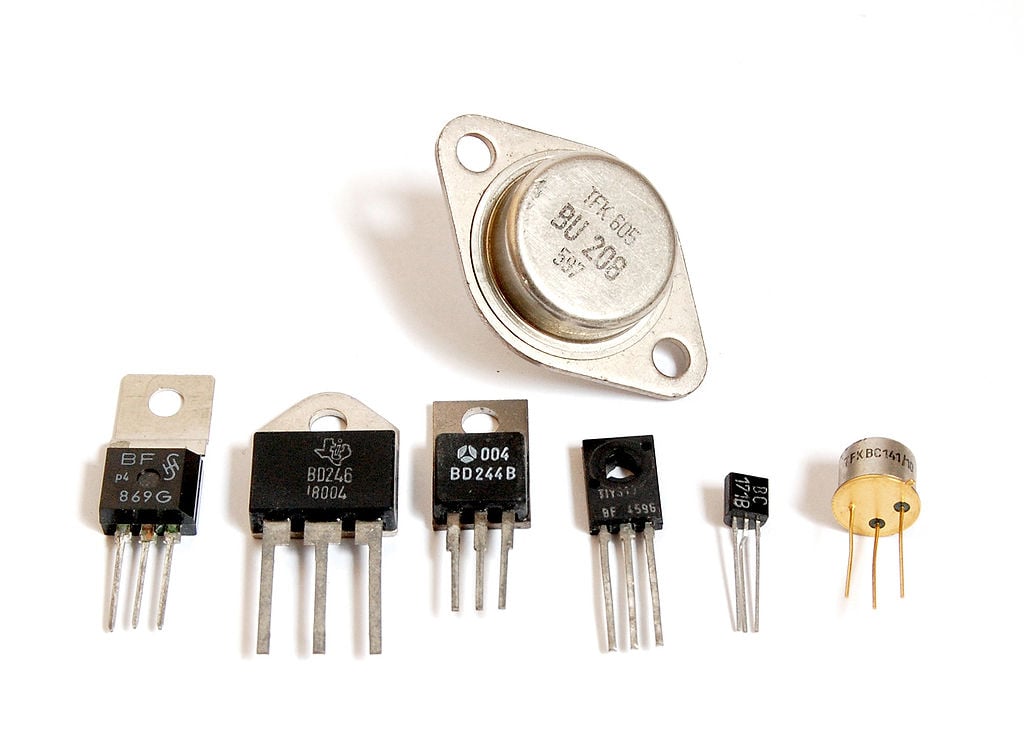One of the most crucial components of an electronic circuit, transistors have revolutionized the field of electronics. These tiny semiconductor devices with three terminals have been around for more than five decades now. They are often used as amplifiers and switching devices. You can think of them as relays without any moving parts because they can turn something ‘on’ or ‘off’ without any movement.

1. Composition
In the beginning, Germanium was used to build transistors which were extremely temperature-sensitive. Today, however, they are made from Silicon, a semiconductor material found in the sand because Silicon transistors are much more temperature-tolerant and cheaper to manufacture. There are two different types of Bipolar Junction Transistors (BJT), NPN and PNP. Each transistor has three pins called Base (b), collector (c), and emitter (e). NPN and PNP refer to the layers of semiconductor material used to make the transistor.
2. How Does It Work?
When you sandwich a p-type silicon slab between two n-type bars, you get an NPN transistor. The emitter is attached to one n-type, while the collector is attached to the other. The base is attached to the p-type. The surplus holes in the p-type silicon act as barriers, blocking the flow of the current. However, if you apply a positive voltage to the base and the collector and negatively charge the emitter, electrons start flowing from the emitter to the collector.
The arrangement and number of p-type and n-type blocks remain inverted in a PNP transistor. In this type of transistor, one n-type is sandwiched between two p-type blocks. As voltage allocation is different, a PNP transistor works differently. An NPN transistor requires a positive voltage to the base, while a PNP requires a negative voltage. In short, the current must flow away from the base to turn a PNP transistor on.
3. Function and Significance
Transistors function as both, switches and amplifiers in most electronic circuits. Designers often use a transistor as a switch because unlike a simple switch, it can turn a small current into a much larger one. Though you can use a simple switch in an ordinary circuit, an advanced circuit may need varying amounts of currents at different stages.
Transistors in Hearing Aids
One of the most well-known applications of transistors is the hearing aid. Usually, a small microphone in the hearing aid picks up the sound waves, converting them into fluctuating electrical pulses or currents. When these currents pass through a transistor, they are amplified. The amplified pulses then pass through a speaker, converting them into sound waves once again. Thus, you can hear a substantially louder version of the surrounding noise.
Transistors in Computers and Calculators
We all know that computers store and process information using the binary language of “zero” and “one.” However, most people don’t know that transistors play a critical role in making something called logic gates, which are the backbones of computer programs. Transistors are often hooked up with logic gates to build a unique piece of an arrangement called a flip-flop. In this system, the transistor remains ‘on’ even if you remove the base current. It now flips on or off whenever new current passes through it. Thus, a transistor can store a zero when it’s off or a one when it’s on, which is the working principle of computers.
Darlington Transistors
A Darlington transistor is made of two PNP or NPN polar junction transistors placed together. It is named after its inventor Sidney Darlington. The sole purpose of a Darlington transistor is to deliver a high current gain from a low base current. You can find these transistors in instruments that require a high current gain at a low frequency such as power regulators, display drivers, motor controllers, light and touch sensors, alarm systems, and audio amplifiers.
IGBT and MOSFET Transistors
The Insulated-Gate Bipolar Transistor (IGBT) transistors are often used as amplifiers and switches in various instruments including electric cars, trains, refrigerators, air-conditioners, and even stereo systems. On the other hand, Metal-Oxide-Semiconductor Field-Effect Transistors (MOSFET) are commonly used in integrated circuits to control a device’s power levels or for storing data.
Related Posts:
